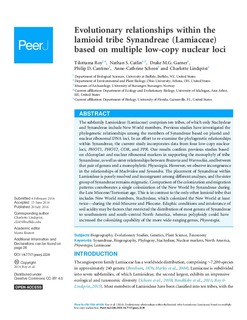| dc.contributor.author | Roy, Tilottama | |
| dc.contributor.author | Catlin, Nathan S. | |
| dc.contributor.author | Garner, Drake M.G. | |
| dc.contributor.author | Cantino, Philip D. | |
| dc.contributor.author | Scheen, Anne-Cathrine | |
| dc.contributor.author | Lindqvist, Charlotte | |
| dc.coverage.spatial | North America | nb_NO |
| dc.date.accessioned | 2018-04-05T12:08:17Z | |
| dc.date.available | 2018-04-05T12:08:17Z | |
| dc.date.created | 2016-10-14T15:22:59Z | |
| dc.date.issued | 2016-07 | |
| dc.identifier.citation | Lindqvist, C. et al. (2016) Evolutionary relationships within the lamioid tribe Synandreae (Lamiaceae) based on multiple low-copy nuclear loci. PeerJ 4:e2220 | nb_NO |
| dc.identifier.issn | 2167-8359 | |
| dc.identifier.uri | http://hdl.handle.net/11250/2492854 | |
| dc.description.abstract | The subfamily Lamioideae (Lamiaceae) comprises ten tribes, of which only Stachydeae and Synandreae include New World members. Previous studies have investigated the phylogenetic relationships among the members of Synandreae based on plastid and nuclear ribosomal DNA loci. In an effort to re-examine the phylogenetic relationships within Synandreae, the current study incorporates data from four low-copy nuclear loci, PHOT1, PHOT2, COR, and PPR. Our results confirm previous studies based on chloroplast and nuclear ribosomal markers in supporting the monophyly of tribe Synandreae, as well as sister relationships between Brazoria and Warnockia, and between that pair of genera and a monophyletic Physostegia. However, we observe incongruence in the relationships of Macbridea and Synandra. The placement of Synandreae within Lamioideae is poorly resolved and incongruent among different analyses, and the sister group of Synandreae remains enigmatic. Comparison of the colonization and migration patterns corroborates a single colonization of the New World by Synandreae during the Late Miocene/Tortonian age. This is in contrast to the only other lamioid tribe that includes New World members, Stachydeae, which colonized the New World at least twice during the mid-Miocene and Pliocene. Edaphic conditions and intolerance of soil acidity may be factors that restricted the distribution of most genera of Synandreae to southeastern and south central North America, whereas polyploidy could have increased the colonizing capability of the more wide-ranging genus, Physostegia. | nb_NO |
| dc.language.iso | eng | nb_NO |
| dc.publisher | PeerJ Inc. | nb_NO |
| dc.rights | Navngivelse 4.0 Internasjonal | * |
| dc.rights.uri | http://creativecommons.org/licenses/by/4.0/deed.no | * |
| dc.subject | biogeography | nb_NO |
| dc.subject | genetikk | nb_NO |
| dc.subject | taksonomi | nb_NO |
| dc.subject | botanikk | nb_NO |
| dc.title | Evolutionary relationships within the lamioid tribe Synandreae (Lamiaceae) based on multiple low-copy nuclear loci | nb_NO |
| dc.type | Journal article | nb_NO |
| dc.type | Peer reviewed | nb_NO |
| dc.description.version | publishedVersion | nb_NO |
| dc.rights.holder | © 2016 Roy et al. | nb_NO |
| dc.subject.nsi | VDP::Matematikk og Naturvitenskap: 400::Basale biofag: 470 | nb_NO |
| dc.subject.nsi | VDP::Humaniora: 000::Arkeologi: 090 | nb_NO |
| dc.source.volume | 2016 | nb_NO |
| dc.source.journal | PeerJ | nb_NO |
| dc.source.issue | 7 | nb_NO |
| dc.identifier.doi | 10.7717/peerj.2220 | |
| dc.identifier.cristin | 1391830 | |
| cristin.unitcode | 217,9,0,0 | |
| cristin.unitname | Arkeologisk museum | |
| cristin.ispublished | true | |
| cristin.fulltext | original | |
| cristin.qualitycode | 1 | |

